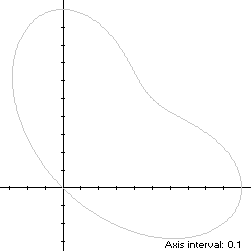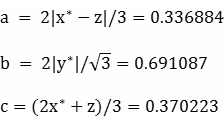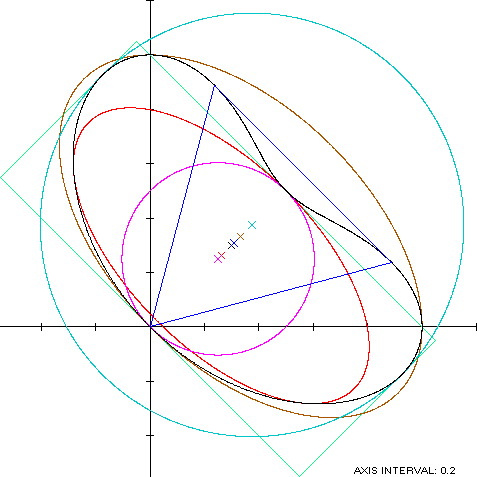Balmoral Software

Balmoral Software

r(t) = sin3(t) + cos3(t), 0 ≤ t < πThe curve is traced around and through the origin in a counterclockwise direction, starting from its maximum abscissa point (1,0) at
r(π/4 + t) = r(π/4 - t),the lima bean curve is symmetric with respect to the line y = x, and is more amenable to analysis after being rotated clockwise by π/4, producing an x-symmetric curve S:
The polar function of the rotated curve is:
rS(t) = sin3(t + π/4) + cos3(t + π/4), 0 ≤ t < π,and the corresponding coordinate functions are
x(t) = rS(t)cos(t) = [sin3(t + π/4) + cos3(t + π/4)]cos(t)The minimum abscissa point of S is the origin at t = π/2; and its two maximum abscissa points arey(t) = rS(t)sin(t) = [sin3(t + π/4) + cos3(t + π/4)]sin(t)
 at
at
The bounding rectangle for inconics is delimited by the ordinate extrema and the cusp

 We have
We have
so by (L2), the perimeter of the convex hull is
which is less than 1% shorter than that of the lima bean curve.
The line segment of the convex hull creates an isosceles triangle with the origin, having area
as shown in blue in the diagram above. The centroid abscissa of this triangle is the average of its vertex abscissas, or
 By
(A2), the remainder of the convex hull has
area
By
(A2), the remainder of the convex hull has
area
By (C2), the associated centroid abscissa is
The convex hull component metrics can be summarized as follows:
The area of the convex hull is 1.019853, about 4% larger than that of the lima bean curve.
Region Area Centroid abscissa Product Triangle Remainder Total
The centroid abscissa of the convex hull of S is the weighted average
After a counterclockwise rotation by π/4, the centroid's position with respect to the lima bean curve is (0.308956,0.308956).
 For verification, we have
For verification, we have
After a counterclockwise rotation by π/4, the incircle's center is (1/4,1/4).
 in
Lemma E,
in
Lemma E,
d/dt [x(t) - z]y(t) = d/dt (-1/8)sin3(t)[-2cos(t) - 3cos(3t) + cos(5t)]has a zero at t* = 1.245619. The corresponding coordinates are
x* = 0.201781We then havey* = 0.598499
For verification,
d/dt [x(t) - z]y(t) = d/dt [26sin(2t) + 2sin(4t) - 6sin(6t) + sin(8t)]/64has a zero at t* = π/4. The corresponding coordinates are
We then have
For verification,
and center abscissa
 For
verification,
For
verification,
After a counterclockwise rotation by π/4, the circumcircle's center is (3/8,3/8).
Figure Parameters Perimeter Area Centroid Incircle 2.221442 0.392699 (0.25,0.25) Inellipse * a = 0.336884
b = 0.6910873.326054 0.731414 (0.370223,0) Lima bean curve Width: 1.282887
Height: 1.2828873.931703 0.981748 (0.3,0.3) Convex hull 3.911279 1.019853 (0.308956,0.308956) Circumellipse * 4.119019 1.209201 (0.471405,0) Circumcircle 4.891247 1.903835 (0.375,0.375) *: With respect to rotated curve S


The rotated lima bean curve (red) is a member of a group of similarly-shaped figures described on these pages, including (inside to outside) the cardioid, the cochleoid and the Cayley sextic.
Copyright © 2021 Balmoral Software (http://www.balmoralsoftware.com). All rights reserved.